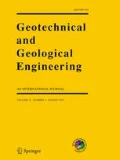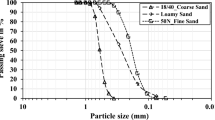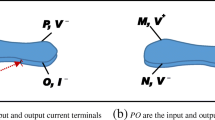Abstract
A 15.25 m wide by 30.50 m long by 1.80 m thick, soil test section (test pad) was constructed to determine the hydraulic conductivity of a proof-of-concept vertical flow bed wetland water treatment system. Specifically, in situ and laboratory hydraulic conductivity tests were performed to confirm if the hydraulic conductivity of the treatment soil within the wetland was equal to or greater than the design requirement of 3.33 × 10−5 cm/s. The in situ hydraulic conductivity measurements were obtained by performing a sealed double ring infiltrometer tests and multiple two-stage borehole infiltration tests. Because of the soil conditions and the implementation of in situ sensors, these two tests were modified. Three types of in situ instrumentation including the time domain reflectrometry, heat dissipation water matric potential sensors, and irrometer tensiometers, were installed into the soil to monitor the movement of the water by measuring the changes of water content and suction as water flow through the soil. In addition, four flexible wall permeameter tests were conducted on Shelby-tube samples to validate the field hydraulic conductivity measurements. A comparison between field and laboratory testing results was completed. The laboratory hydraulic conductivity values were significantly lower than in situ hydraulic conductivity values, and also lower than the design requirement value. The in situ tests results met the 3.33 × 10−5 cm/s requirement, with the exception of a few of the values that were obtained from a borehole where highly plasticity clay was observed.












Similar content being viewed by others
References
American Society for Testing and Materials (2013a) Standard test methods for particles-size analysis of soils. In: Annual book of ASTM standards, designation D422, vol 4.08. ASTM, West Conshohocken
American Society for Testing and Materials (2013b) Standard test methods for amount of materials for specific gravity of soil solids by water pycnometer. In: Annual book of ASTM standards, designation D854, vol 4.08. ASTM, West Conshohocken
American Society for Testing and Materials (2013c) Standard test methods for amount of materials in soil finer that no. 200(75-μm) sieve. In: Annual book of ASTM standards designation D1140, vol 4.08. ASTM, West Conshohocken
American Society for Testing and Materials (2013d) Standard test methods for laboratory determination of water (moisture) content of soil and rock by mass. In: Annual book of ASTM standards, designation D2216, vol 4.08. ASTM, West Conshohocken
American Society for Testing and Materials (2013e) Standard practice for description and identification of soils (visual-manual) procedure. In: Annual book of ASTM standards, designation D2488, vol 4.08, ASTM, West Conshohocken
American Society for Testing and Materials (2013f) Standard test methods for infiltration rate of soils in field using double-ring infiltrometer. In: Annual book of ASTM standards, designation D3385, vol 4.08. ASTM, West Conshohocken
American Society for Testing and Materials (2013g) Standard test methods for liquid limit, plastic limit, and plasticity index of soils. In: Annual book of ASTM standards, designation D4318, vol 4.08. ASTM, West Conshohocken
American Society for Testing and Materials (2013h) Standard test methods for measurement of hydraulic conductivity of saturated porous materials using a flexible wall permeameter. In: Annual book of ASTM standards, designation D5084, vol 4.08. ASTM, West Conshohocken
American Society for Testing and Materials (2013i) Standard test methods for field measurement of infiltration using double-ring infiltrometer with sealed-inner ring. In: Annual book of ASTM standards, designation D5093, vol 4.08. ASTM, West Conshohocken
American Society for Testing and Materials (2013j) Field measurement of hydraulic conductivity limits of porous materials using two stages of infiltration from a borehole. In: Annual book of ASTM standards, designation D6391, vol 4.09. ASTM, West Conshohocken
American Society for Testing and Materials (2013k) Standard test method for in-place density and water content of soil and soil-aggregate by nuclear methods (shallow depth). In: Annual book of ASTM standards, designation D6938, vol 4.09. ASTM, West Conshohocken
Benson CH, Daniel DE, Boutwell GP (1999a) Field measurement of compacted clay liners. J Geotech Geoenviron Eng ASCE 125(5):390–403
Benson C, Abichou T, Wang X, Gee G, Albright W (1999b) Test section installation instructions-alternative cover assessment program. Environmental Geotechnics Report 99-3. Department of Civil and Environmental Engineering, University of Wisconsin, Madison
Boutwell G (1992) The STEI two-stage borehole field permeability test. In: Containment liner technology and subtitle “D”, Houston section. ASCE, Houston
Boutwell GP, Derick RK (1986) Groundwater protection for sanitary landfills in the saturated zone. Presented to Waste Tech’86, National Solid Waste Management Association, Chicago
Boutwell GP, Tsai CN (1992) The two-stage field permeability test for clay liners. Geotech News 10(2):32–34
Boynton SS, Daniel DE (1985) Hydraulic conductivity tests on compacted clay. J Geotech Eng ASCE 111(4):465–478
Campbell Scientific Inc. (2013a) TDR Probes CS605, CS610, CS630, CS635, CS640, and CS645, Instruction manual. Campbell Scientific Website. Retrieved Feb 2014
Campbell Scientific Inc. (2013b) 229 Heat dissipation matric water potential sensor, Instruction manual. Campbell Scientific Website. Retrieved Feb 2014
Daniel D (1989) In situ hydraulic conductivity tests for compacted clay. J Geotech Geoenviron Eng ASCE 115(9):1205–1226
Daniel DE, Trautwein S (1986) Field permeability test for earthen liners. In: Proceedings of In-situ’86, Blacksburg, pp 146–160
Daniel DE, Trautwein SJ, Boynton SS, Foreman DE (1984) Permeability testing with flexible-wall permeameter. Geotech Test J 7(3):113–122
Darcy H (1856) Les Fontaines Publiques de la Ville de Dijon, Dalmont, 647 pages
Day SR, Daniel DE (1985a) Hydraulic conductivity of two prototype clay liners. J Geotech Eng ASCE 111(8):957–970
Day SR, Daniel DE (1985b) Field permeability test for clay liners. ASTM STP874, pp 276–288
Evett S (2003) Soil water measurement by time domain reflectrometry. In: Encyclopedia of water science, pp 894–898
Hvorslev J (1951) Time lag and soil permeability in ground water observations. Bulletin no. 36, USA/COE WES Vicksburg
Kazimoglu YK, McDougall JR, Pyrah IC (2006) Unsaturated hydraulic conductivity of landfilled waste. School of the Built Environment, Napier University, Edinburgh. ASCE 2006
Lambe TW (1954) The permeability of compacted fine-grained soils. ASTM STP 163:56–67
Lambe TW (1958) The engineering behavior of compacted clay. J Soil Mech Found Div ASCE 84(SM2):1–35 (Paper no. 1655)
Ledieu J, De Ridder P, De Clerck P, Dautrebande S (1986) A method of measuring soil moisture by time-domain reflectometry. J Hydrol 88:319–328
Menziani M, Rivasi MR, Pugnaghi S, Santangelo R, Vincenzi S (1996) Soil volumetric water content measurements using TDR technique. Ann Geofis 39(1):91–96
Mitchell JK, Hooper DR, Campanella RG (1965) Permeability of compacted clay. J Soil Mech Found Div ASCE 91(4):41–65
Nanak MJ (2013) Variability in the hydraulic conductivity of a test pad liner system using different testing techniques. M.S. Thesis, University of Arkansas
Nemmers C (1998) Volumetric moisture content using time domain reflectrometry. FHWA publication number: FHWA-RD-97-139
Phene C, Rawlins S, Hoffman G (1971) Measuring soil matric potential in-situ by sensing heat dissipation within a porous body: I. Theory and sensor construction. Soil Sci Soc Am J 35:27–33
Reece CF (1996) Evaluation of a line heat dissipation sensor for measuring soil matric potential. Soil Sci Soc Am J 60:1022–1028
Ridley A, Marsland F, Patel A (1998) Tensiometers: their design and use for civil engineering purposes. In: Robertson PK, Mayne PW (eds) Proceedings of 1st international conference on site characterization, Atlanta, vol 2, pp 851–856
Roesler AC, Benson CH, Albright WH (2002) Field hydrology and model predictions for final covers in the alternative assessment program-2002. Geo Engineering Report No. 02-08, Department of Civil and Environmental Engineering, University of Wisconsin, Madison
Scott P, Suryasasmita V (2006) Comparison of hydraulic conductivity test methods for landfill clay liners. In: Unsaturated soil, seepage, and environmental geotechnics, pp 364–372
Soil Testing Engineers Inc. (1983) STEI two-stage field permeability test. Soil Testing Engineers Inc., Baton Rouge
Take WA, Bolton MD (2003) Tensiometer saturation and the reliable measurement of matric suction. Geotechnique 53(2):159–172
Topp GC, Yanuka M, Zebchuck WD, Zegelin S (1988) Determination of electrical conductivity using time domain reflectrometer: soil and water experiments on coaxial limes. Water Resour 24:945–952
Trautwein S, Boutwell G (1994) In situ hydraulic conductivity tests for compacted soil liners and caps. In: Daniel D, Trautwein S (eds) Hydraulic conductivity and waste contaminant transport in soil, STP 1142. ASTM, Philadelphia, pp 184–223
United States Environmental Protection Agency (1992) Subtitle D clarification. Fed Reg 57(124):28626–28632
Acknowledgements
The authors acknowledge that this project was made possible by financial and in-kind support from Burns and McDonnell Engineers, Inc., WESTAR Energy Corporation, Terracon Consulting Engineers, and the Bergkamp Construction Company.
Author information
Authors and Affiliations
Corresponding author
Rights and permissions
About this article
Cite this article
Ishimwe, E., Garner, C.D. & Coffman, R.A. Full-Scale Hydro-Mechanical Properties of Vertical Flow Bed Treatment Soils. Geotech Geol Eng 36, 2735–2748 (2018). https://doi.org/10.1007/s10706-018-0495-x
Received:
Accepted:
Published:
Issue Date:
DOI: https://doi.org/10.1007/s10706-018-0495-x




